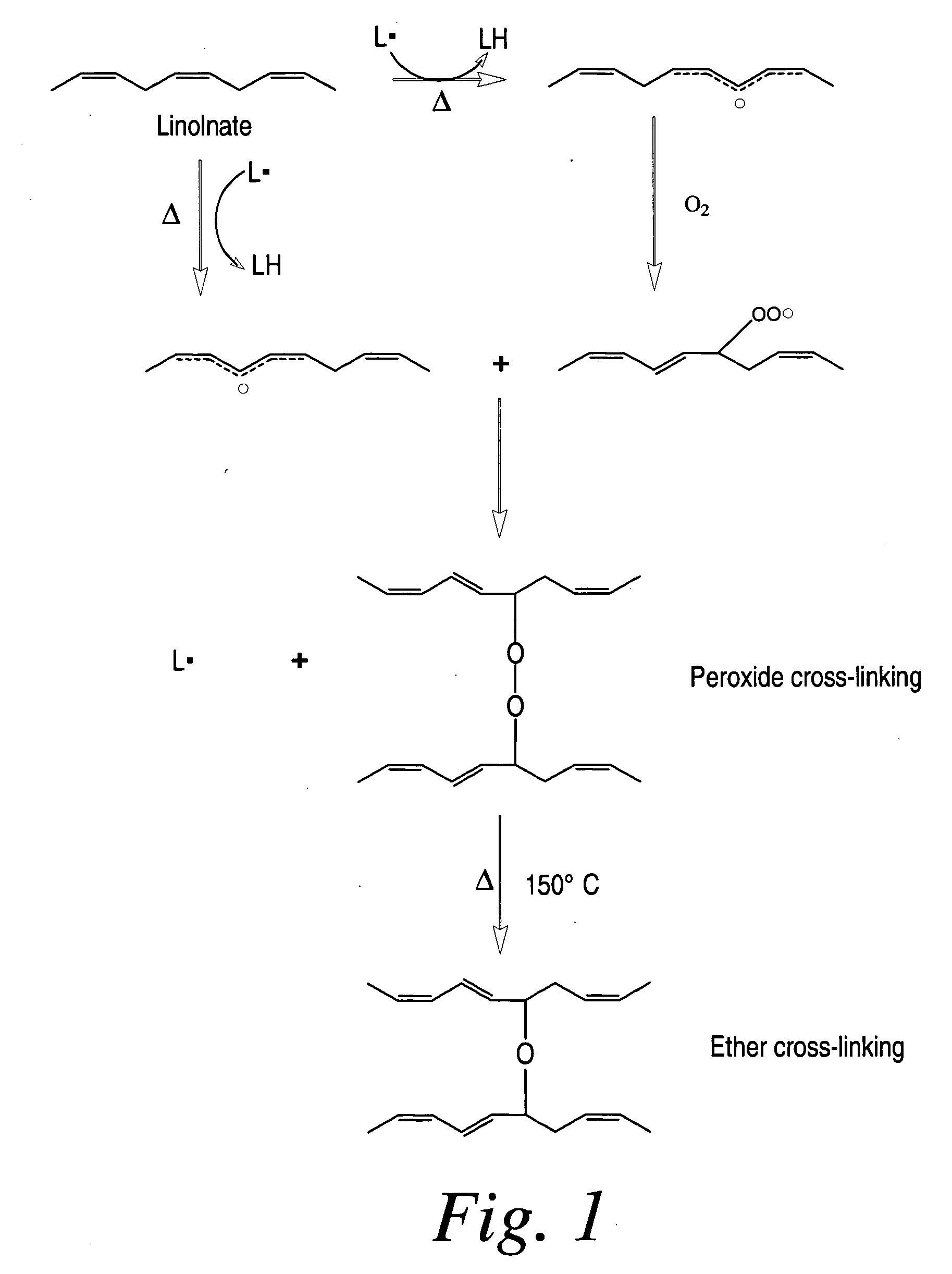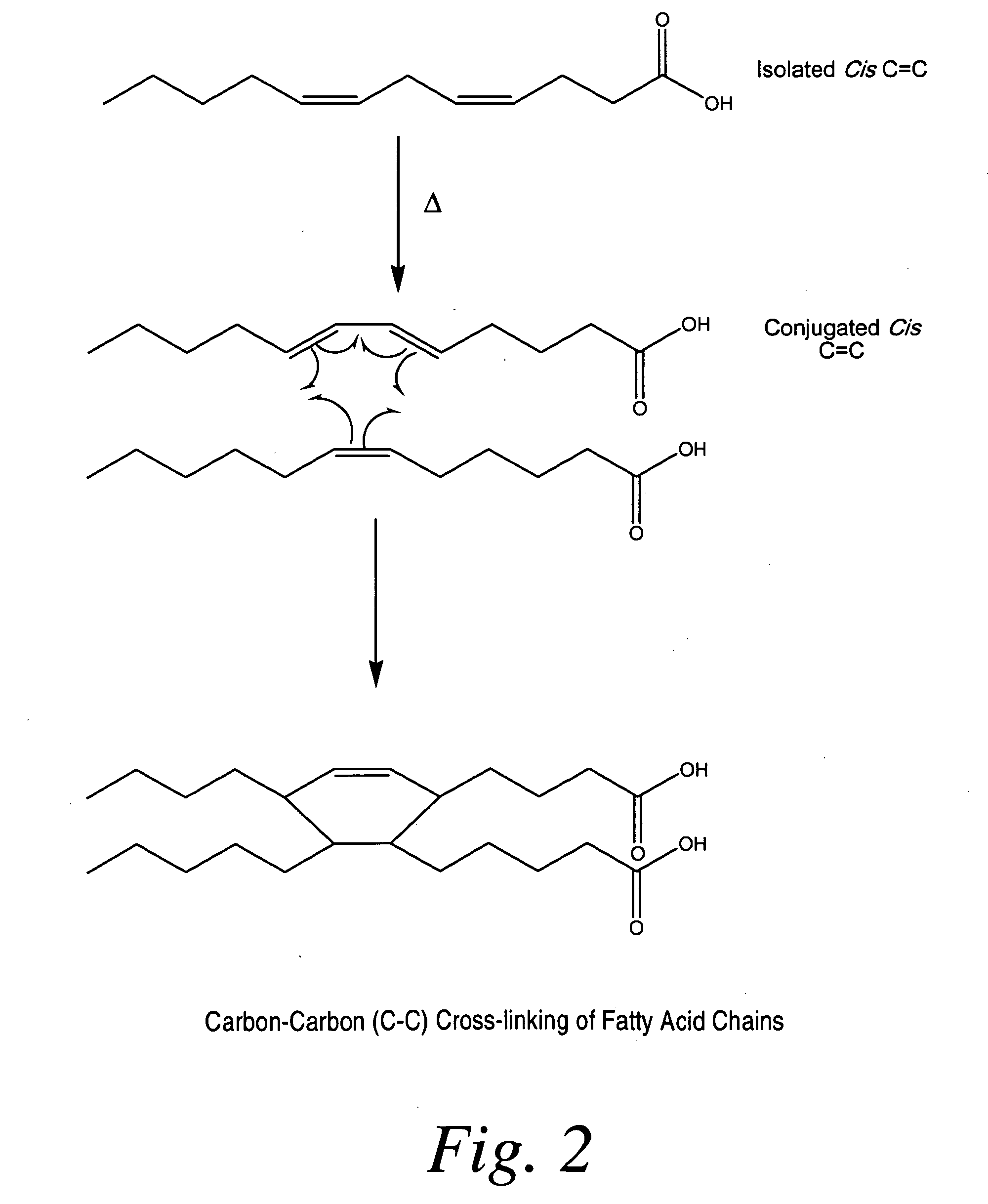Cross-linked fatty acid-based biomaterials
- Summary
- Abstract
- Description
- Claims
- Application Information
AI Technical Summary
Benefits of technology
Problems solved by technology
Method used
Image
Examples
example 1
Characterization of a Novel Biomaterial Derived from Fish Oil
[0178]In this example, coated medical devices (e.g., a polypropylene mesh) were cured in a high airflow oven at 200° F. for 24 hours, after which the fish oil was converted into a cross-linked biomaterial coating encapsulating the polypropylene mesh by oxidation of the C═C bonds present in the fish oil resulting in the formation of oxidative byproducts (i.e., hydrocarbons, aldehydes, ketones, glycerides, fatty acids) while largely preserving the esters derived from the original oil triglycerides. Volatilization of the byproducts followed by the formation of ester and lactone cross-links result in the solidification of oil into a bioabsorbable hydrophobic cross-linked fatty acid-derived biomaterial. FTIR, X-ray diffraction, and GC-FID fatty acid compositional analysis and GC-MS were performed on the fish oil derived coatings to characterize its chemistry.
[0179]FTIR Analysis: FIG. 11 is an FTIR analysis, which illustrates a ...
example 2
Characterization of Novel Biomaterials Derived from Other Oil Starting Materials
[0183]In Example 2, separate coated medical devices were cured in a high airflow oven at 200° F. for 24 hours, using flax seed, fish, grape seed, or olive oils as the starting material in order to determine the effects of initial fatty acid starting chemistry on the ability to form a non-polymeric, fatty acid-derived hydrophobic biomaterial coating by the oxidative cross-linking mechanisms described in Example 1. After the curing process, the physical properties of each fatty acid-derived coating were noted in addition to being analyzed using FTIR, GC-FID fatty acid profile, and GC-FID aldehyde assay testing.
[0184]Physical Properties: Table 2 presents a summary of the physical properties observed in each oil coating after curing at 200° F. for 24 hours.
TABLE 2Oil CoatingPhysical PropertiesOlive OilLiquidGrape seed OilSlightly stickyFlax seed OilDry coatingFish OilDry coating
[0185]FTIR Analysis: FIG. 15 s...
example 3
In-Vitro Hydration Ability of a Novel Biomaterial Derived from Fish Oil
[0190]The following example characterizes the ability of the novel fatty acid-based hydrophobic cross-linked biomaterial to be hydrated and hydrolyzed, and to identify the chemical structure of the elution components released from the material from in-vitro and in-vivo experiments.
[0191]Coated medical devices were cured in a high airflow oven at 200° F. for 24 hours, after which the fish oil was converted into a fatty acid derived biomaterial coating encapsulating the polypropylene mesh by oxidation of the C═C bonds present in the fish oil resulting in the formation of oxidative byproducts (i.e., hydrocarbons, aldehydes, ketones, glycerides, fatty acids) while largely preserving the esters derived from the original oil triglycerides. Volatilization of the byproducts followed by the formation of ester and lactone cross-links result in the solidification of oil into a bioabsorbable hydrophobic cross-linked biomater...
PUM
| Property | Measurement | Unit |
|---|---|---|
| Temperature | aaaaa | aaaaa |
| Temperature | aaaaa | aaaaa |
| Fraction | aaaaa | aaaaa |
Abstract
Description
Claims
Application Information
 Login to View More
Login to View More - R&D
- Intellectual Property
- Life Sciences
- Materials
- Tech Scout
- Unparalleled Data Quality
- Higher Quality Content
- 60% Fewer Hallucinations
Browse by: Latest US Patents, China's latest patents, Technical Efficacy Thesaurus, Application Domain, Technology Topic, Popular Technical Reports.
© 2025 PatSnap. All rights reserved.Legal|Privacy policy|Modern Slavery Act Transparency Statement|Sitemap|About US| Contact US: help@patsnap.com



